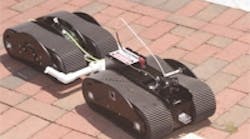The United Nations estimates there are more than 100 million land mines worldwide, and that more than 2,000 people are killed or maimed by explosions each month.
Looking for a safe way to locate these hazards, Carl V. Nelson, a principal staff physicist at The John Hopkins University Applied Physics Laboratory, developed sensors to help detect land mines. But he needed a device to carry them into areas of thick vegetation, where explosives are often hidden.
Four undergraduate engineering students came up with a solution. They designed and built a remotecontrolled robotic vehicle that finds mines hidden in rugged terrain and marks their location with a paint spray. The prototype has been given to professional explosive-detection researchers as a model for a low-cost robot that humanitarian groups and military troops could use to prevent mine-related deaths and injuries.
The two-piece vehicle rolls on tank-type treads. The front portion moves the robot using two cordless-powerdrill motors connected to a sealed lead-acid battery. Atop the drive segment is a color video camera that lets operators see what the robot encounters.
The second unit houses a simple metal-detection coil from an off-the-shelf metal detector, which would be replaced by more sophisticated sensors if the model is used by funded researchers. The rear segment also holds a small storage tank and spray-paint nozzle.
To steer the robot from a safe distance, the students constructed a batterypowered controller with joystick. The controller features a small video screen that displays real-time images from the robot’s camera. When metal is detected, a beep is heard over a speaker on the controller or headphones worn by the operator. A switch on the controller activates the paint sprayer.
The vehicle is mostly made of plastic and other nonmetal parts to reduce cost and weight. Using non-metal parts avoids false-positive readings from the mine detector. The two-segment design also spreads out the robot’s weight, making the device less likely to set off a mine.

